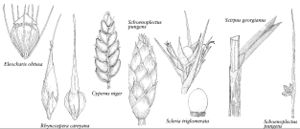Scleria
Kongl. Vetensk. Acad. Handl. 26: 142, plates 4, 5. 1765.
Herbs usually perennial, sometimes annual, cespitose or not, rhizomatous or not. Culms solitary or not, unbranched proximal to inflorescence, trigonous, (6–)10–100(–125) cm (high-climbing into trees), weak or wiry. Leaves few to many per culm, cauline, 3-ranked; sheaths present; ligules usually well developed, sometimes obsolete; blades well developed (or rudimentary, sometimes absent on proximal leaves), shorter than, equaling, or overtopping culms, plane, keeled, or revolute, 0.5–9 mm wide, stiff, with prominent midvein, glabrous, scabrous, or pubescent. Inflorescences terminal, often axillary, sometimes pseudolateral, panicles, spikes, or 1 or more capitate or fasciculate clusters; spikelets 1–100+; bracts 1–3, ascending or erect, bristle-shaped, awl-shaped, or leaflike, sometimes appearing to be continuation of culm, 10–150 mm, shorter than or exceeding spikelets, glabrous or ciliate. Spikelets: scales 3–10+, each subtending flower, distichous, proximal 2–4 scales empty, proximal fertile scale pistillate, distal fertile scales staminate or sometimes empty; occasionally some spikelets entirely pistillate or staminate. Flowers unisexual; perianth absent; stamens 1–3; anthers 2–4 mm, apex usually mucronate or awned; styles linear, 2–3-fid, base deciduous or persistent, hypogynium rudimentary or prominent, slender or enlarged. Achenes trigonous or rounded, 1–4 mm, smooth, tuberculate, verrucose, or reticulate, occasionally pubescent.
Distribution
Tropical and warm-temperate regions of both hemispheres.
Discussion
Species ca. 200 (14 in the flora).
Unusual structures provide important taxonomic markers in Scleria, necessitating some specialized terminology. The hypogynium is a peculiar, hardened disc at the base of the achene. In some species the hypogynium forms a prominent collar, while in others it is an inconspicuous ridge around the point of attachment of the achene. Before the achene abscises, the hypogynium is attached to a concave disc, the cupula, which remains with the inflorescence when the achene is shed. The contra-ligule (sometimes called the ligula) is a membranous flap on the rim of the leaf sheath on the opposite side from the blade. Contra-ligules are present in some other genera of Cyperaceae; their structure is seldom used taxonomically outside Scleria.
Scleria vaginata Steudel, native to Central and South America, was collected once as an adventive in southern Florida, where it is an aggressive vine over two meters. The hypogynium is well developed but lacks tubercles, and the achene is smooth, shining, and gray or purplish.
Selected References
Lower Taxa
Key
| 1 | Hypogynium absent or vestigial, achene base tapered, indented or with small pits, appearing continuous with achene body in texture and color. | > 2 |
| 1 | Hypogynium present, appearing as basal zone differentiated from rest of achene by change in tissue appearance or physical border or gap or both. | > 6 |
| 2 | Achenes reticulate; plants annuals with weak bases, lacking rhizomes, with fibrous roots. | Scleria verticillata |
| 2 | Achenes essentially smooth; plants perennials with firm bases, with rhizomes. | > 3 |
| 3 | Inflorescences ± branched, spicate-paniculate; contra-ligules well developed, ciliate. | Scleria lithosperma |
| 3 | Inflorescences not obviously branched, headlike or spikelike; contra-ligules minute or absent. | > 4 |
| 4 | Inflorescence interruptedly spicate. | Scleria distans |
| 4 | Inflorescence a single cluster at summit of culm. | > 5 |
| 5 | Achenes 3–4 mm, base indented, without granulose pits. | Scleria baldwinii |
| 5 | Achenes 2–3 mm, base with 6 granulose pits. | Scleria georgiana |
| 6 | Leaves 10–25 mm wide; hypogynium bluntly 3-angled, smooth; main stem strongly retrorsely scabrous. | Scleria lacustris |
| 6 | Leaves 1–9 mm wide; hypogynium of lobes, papillose tubercles, or continuous papillose band; main stem ciliate or smooth. | > 7 |
| 7 | Hypogynium with narrow, smooth base proximal to 8–9 small, rounded, papillose tubercles. | Scleria oligantha |
| 7 | Hypogynium with 3 or 6 lobes or papillose tubercles or continuous and papillate with neither lobes nor distinct tubercles. | > 8 |
| 8 | Hypogynium continuous and without distinct lobes or tubercles, densely covered with whitish to brownish papillae; body of achene smooth. | > 9 |
| 8 | Hypogynium with 3 or 6 lobes or tubercles; body of achene usually reticulate or papillose. | > 10 |
| 9 | Leaves 3–9 mm wide; achenes 2–3 mm. | Scleria triglomerata |
| 9 | Leaves 1–2.5 mm wide; achenes 1.5–2 mm. | Scleria minor |
| 10 | Hypogynium with 3 oblong lobes; inflorescence paniculate, with visible branches. | > 11 |
| 10 | Hypogynium not distinctly 3-lobed, with 3 or 6 tubercles; inflorescence with spikelets in dense clusters, lacking obvious branches. | > 12 |
| 11 | Proximalmost lateral panicle spreading or drooping on filiform, flexuous peduncle (15–)20–100 mm; achene usually with tufts or lines of spreading, whitish or tawny hairs on ridges, rarely glabrous; distalmost lateral panicle with bract (including sheath) usually 1/4–3/4 length of terminal internode. | Scleria muehlenbergii |
| 11 | Proximalmost lateral panicle erect, sessile or on stiff, ± erect peduncle to 20(–90) mm; achene glabrous; distalmost lateral panicle with bract (including sheath) usually 3/4 or more length of terminal internode. | Scleria reticularis |
| 12 | Achenes reticulate-ridged. | Scleria curtissii |
| 12 | Achenes tuberculate, verrucose, or papillate, rarely nearly smooth. | > 13 |
| 13 | Hypogynium with 6 distinctly separate tubercles arranged in pairs; achenes 1–2.5 mm; leaves 1–2.5 mm wide. | Scleria pauciflora |
| 13 | Hypogynium with 3 tubercles (these often irregular or 2-lobed); achenes 2–3.5 mm; leaves 1–7 mm wide. | Scleria ciliata |
